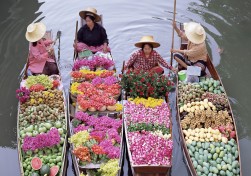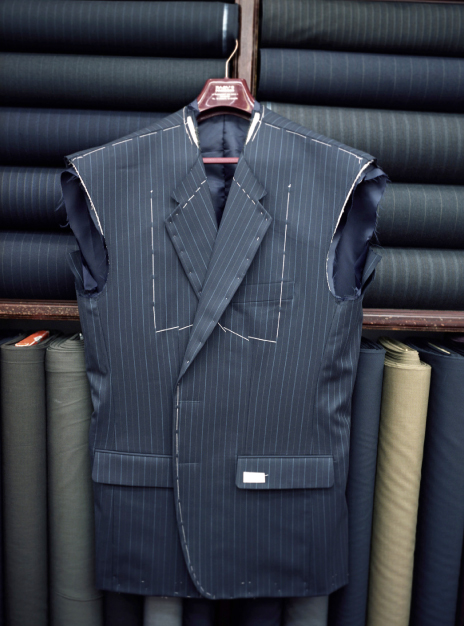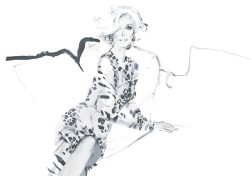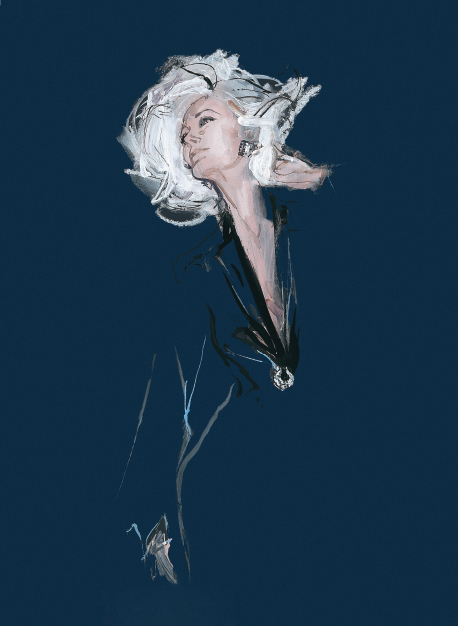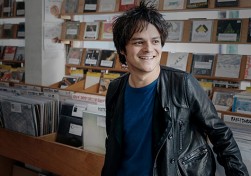Bangkok has long been a compelling place to visit, a culturally rich Southeast Asian capital that has managed to retain a strong national identity despite rapid development. What has given the city an additional edge for luxury travelers today is that, as well as being home to gilded Thai temples, craft emporiums and markets rich in color and culture, it has developed a booming urban arts scene and remarkably sophisticated eating and drinking venues.
When exactly Bangkok changed from being a hedonistic backpacker paradise and temple city into a budding food and shopping destination is difficult to pinpoint. Some argue that it was the arrival of designers such as Ashley Sutton, who created the iconic Bangkok bars Maggie Choo’s and Iron Fairies, that has propelled the city into the future far faster than other tourist favorites such as Ho Chi Minh City and Phnom Pen. Others believe Bangkok’s rise to fame as the cool kid in Southeast Asia arrived when locals started to merge hip Western trends with local culture. “All the successful launches in the last five years have been of lifestyle establishments that have involved something else,” says Daniel Fraser, co-founder of luxury tour group Smiling Albino. “For instance, open art forums at night that also work as bars, restaurants that operate as art galleries and bars that double as performance theaters.”
The food, too, has evolved enormously in the city, he adds. “People always came for the street food, and still do. But now they might have street food at a market one night and a five-star dinner by a Michelin-starred chef like Joël Robuchon the next.”
As in many cities, some of the richest experiences, both contemporary and historical, are best accessed with the help of knowledgeable local guides or insider information. Here we offer a handful to make the best of your stay.
Design a custom suit
A trip to a tailor is now as synonymous with Bangkok as a dizzying ride in a tuk-tuk. Just like the tuk-tuks, tailors occupy practically every corner, jockeying for business from passing pedestrians. Enter Tailor on Ten, the antithesis of the typically crowded shop lined with fake designer fabrics. Run by Canadian brothers Ben and Alex Cole, the spacious store features private fitting rooms, on-site master tailors and fine Italian fabrics by manufacturers such as Loro Piana. What keeps international businessmen and ambassadors alike returning to Tailor on Ten is the attention to detail. Customers come for three fittings during a week and the Coles’ team personally selects every shoulder pad, interlining, button and thread used in the making of the shirts and suits. For men, sipping beer and crafting a new wardrobe or tuxedo gives them the ultimate kid-in-a-candy-shop feeling.
Suits from $400; tailoronten.com
Train with a martial arts star
On the outskirts of Bangkok, hard-bodied Thai men in brightly colored satin shorts enter the black-and-red-checkered ring at Luktupfah Muay Thai Academy for a full day of classic Muay Thai lessons with world-renowned trainer, Chinawut Sirisompan (known as Grand Master Woody). Spending the day with the Muay Thai pioneer, who was among the first to bring the sport to the West and is the founder of the Amateur Muay Thai World Championships, is equal parts history lesson and intense physical training. A day camp starts with a brief history of the sport and a breakdown of the rules and techniques before a warm-up run through nearby rice fields and villages. Back at the gym, there’s time to spar in the ring while a videographer captures the moves. When the grunting and combat is over, students can enjoy a Thai massage, time in the sauna and lunch before returning to Bangkok in a private car – with a few bruises and a new-found respect for the ancient Thai martial arts.
From $12 a session; luktupfah-muaythai.com
Fly over the city in a helicopter
The noise from the churning rotors quickly rises as the helicopter lifts above Bangkok’s crowded streets. The most shocking discovery of this 50-minute aerial trek is just how disorganized the Thai capital is, lacking the city planning, wide sidewalks and defined downtown areas of many major cities. But that lack of polish and orderly chaos is exactly what gives Bangkok its buzz, its magnetism, its charm. Whizzing above the Chao Phraya River, it’s possible to get a bird’s-eye view of the most iconic sights in town: the intricate canal systems, and the ancient Wat Arun and Grand Palace. Back on land, the journey ends with a private car back into the city.
About $1,600 for two, eastmeetswesttravel.com
Take Thai cooking lessons
Blue Elephant restaurant has long been Thailand’s unofficial culinary ambassador, showcasing the beauty and diversity of Royal Thai cuisine. Lessons are led by the restaurant’s leading chefs or, on request, the founder and executive head chef, Nooror Somany Steppe. Each student has a cooking station and wok, and time is spent both in the classroom and in the kitchen. A single morning’s lesson might involve taking an hour-long trip to the nearby Bangrak Market to shop for such typical Thai ingredients as bird’s eye chili and dried shrimp, then learning to cook four authentic dishes such as massaman curry with beef, pomelo salad, Thai fishcakes and a hot and sour soup. Lessons are in a beautiful colonial-style mansion, and at the end of the lesson students can feast in the elegant living room filled with dark rattan furniture and Asian artefacts.
From about $150, blueelephant.com
Tour the flower market
Pak Khlong Talat, Bangkok’s 24-hour flower market, is a place in which almost every visitor experiences a slight sensory overload. Exotic fragrances fill the air as fast-speaking Thais quickly exchange their crumpled baht bills for bushels of flowers. An astounding number of blooms come to the market daily from around Thailand, including orchids in myriad colors, roses, lotus buds sold chilled on ice and marigold blossoms strung into garlands. Navigating the maze of passageways and warehouse rooms is best done with a guide and, better yet, a botanist. The most renowned is Sakul Intakul, the director and creator of the Museum of Floral Culture in Bangkok, who specializes in flower art and installations. A tip: it’s worth buying not just flowers but a vase to create an arrangement for your hotel room.
From $800 for two; smilingalbino.com
Hunt for Asian antiques
House of Chao, a slightly dusty three-story antique house, is decked out with antiques and curiosities from Thailand and neighboring Asian countries including Myanmar, China and India. Known mostly to antique collectors and aficionados of teak furniture, the emporium harbors an assortment of genuine curiosities, ancient treasures, pseudo-antiques and impressive-looking replicas sourced by its charming owner, Khun Chaovanee, who also attends to their restoration. Among the ornaments, carpets, textiles, Thai silk and artwork there are some serious collectibles and one of Thailand’s largest selections of traditional Burmese furniture. Chaovanee is authoritative (and honest) on the provenance of her wares, and can happily arrange for goods to be shipped all over the world.
9/1 Decho Road, Silom; +662 635 7188
Meditate with a yoga teacher
With American founder Adrian Cox at the helm, Yoga Elements Studio has garnered a reputation for being not just the best yoga center in Bangkok, but one of the best in the world. Situated on the 23rd floor of a high-rise near to Chit Lom BTS skytrain station, the studio’s teachers instruct in vinyasa and ashtanga yoga in classes that run through the day from 7am until 9.15pm. Cox, a yoga teacher for more than 15 years, has devoted himself to the study of meditation, philosophy, Ayurveda and linguistics, and trained with gurus in New York City and India. In addition to taking yoga classes, he offers a meditation session to those who want to chill out completely on Saturday afternoons. For those who want to take the discipline further, he also offers a 200-hour teaching training course.
From about $15 for a drop-in class; yogaelements.com
Commission a bespoke table
Belgian former antique dealers, Pieter Compernol and Stephanie Grusenmeyer, set out to create a line of bespoke, hand-crafted tables after unearthing large antique wooden boards in a remote Asian village and deciding to remodel them. The result of their creative efforts is P Tendercool, a chic studio-cum-showroom near the Chao Phraya river that sells the sort of bespoke contemporary pieces that are snapped up by top interior designers around the world. Tabletops are made from antique wooden slabs salvaged from Asian homes or kiln-dried reclaimed beams from colonial buildings. Bases and legs are hand-cast from bronze, aluminum or brass and forged by expert Thai craftsmen. Those who don’t want to design their own furniture can choose from ready-made pieces ranging from dining sets and desks to stools, benches and consoles. International shipping can be arranged.
Your address: The St. Regis Bangkok
